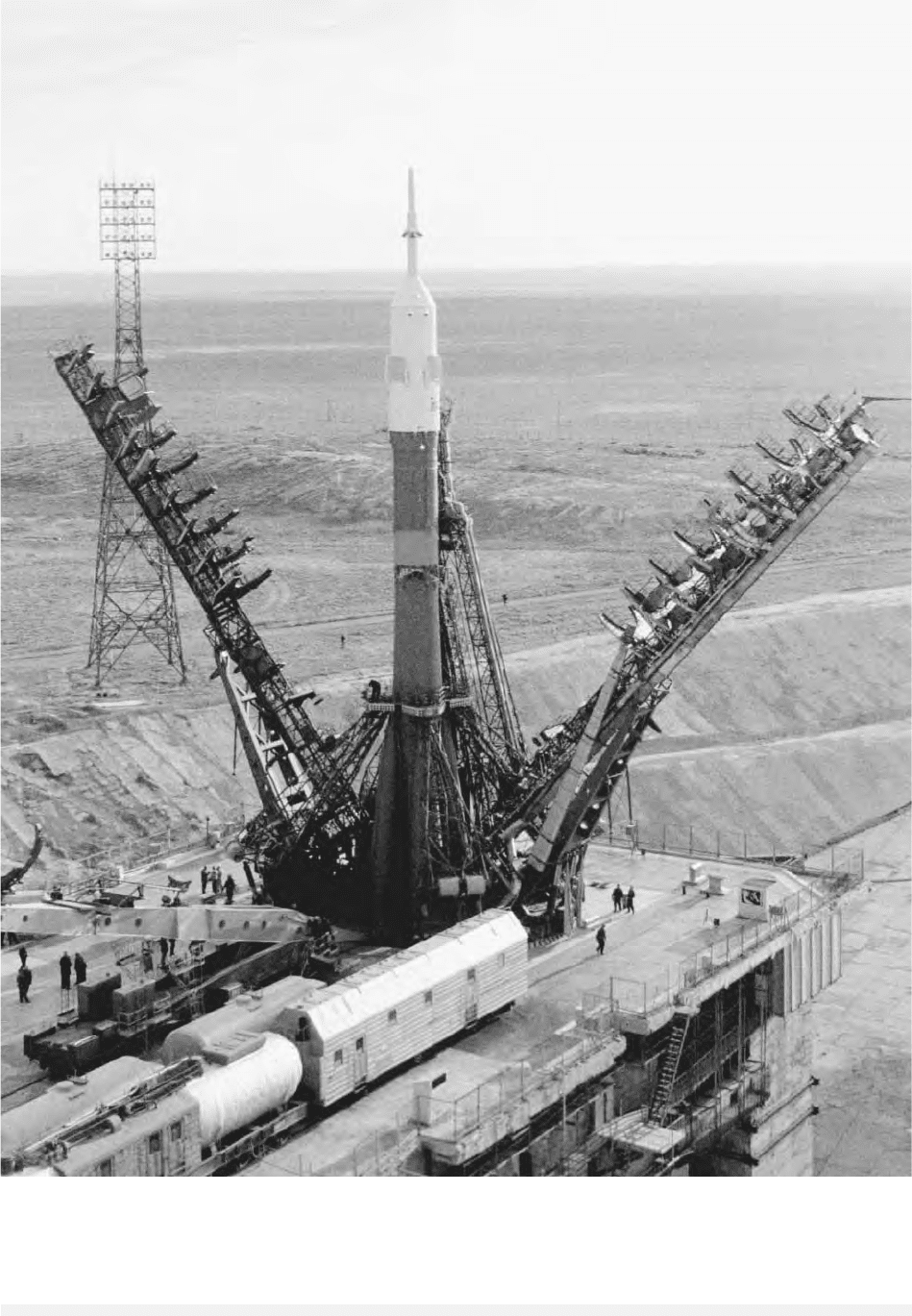Encyclopedia of Russian History
Подождите немного. Документ загружается.


See also: CATHERINE II; GREAT NORTHERN WAR; PEAS-
ANTRY; PETER I; TAXES
BIBLIOGRAPHY
Kahan, Arcadius. (1985). The Plow, the Hammer, and the
Knout: An Economic History of Eighteenth-Century Rus-
sia. Chicago: University of Chicago Press.
Lyashchenko, Peter I. (1949). History of the National
Economy of Russia to the 1917 Revolution, tr. Leon M.
Herman. New York: Macmillan.
M
ARTIN
C. S
PECHLER
SOVIET
Soviet (sovet) is the Russian word for “council” or
“advice.”
Its political usage began during the Revolution
of 1905 when it was applied to the councils of
deputies elected by workers in factories throughout
Russia. Although suppressed in 1905, the soviets
reappeared in nearly every possible setting immedi-
ately following the February Revolution of 1917.
With the soviet in Petrograd setting the tone, they
very quickly became the organs of power that the
majority of the population saw as legitimate. Al-
though the moderate socialists who initially led the
soviets were reluctant to take executive power from
the Provisional Government, most Russians seem to
have favored rule by the soviets alone; the Bolshe-
viks’ call for “All Power to the Soviets” may well
have been their most successful slogan. The Octo-
ber Revolution was timed to coincide with the Sec-
ond All-Russian Congress of Soviets, both to
forestall its taking power without Bolshevik initia-
tive and to gain legitimacy from its approval. The
new Bolshevik-led government was thus initially
based on soviets, and the state structure formally
remained so until Mikhail Gorbachev. For most of
the Soviet era, the Supreme Soviet was theoretically
the highest legislative organ, although the Com-
munist Party held practical power. Throughout
their history, soviets generally proved too large for
day-to-day governance, a role filled by a permanent
executive committee elected by the full soviet. Some
scholars have suggested that the soviet became so
popular an institution because it was an urban
counterpart to the village commune assembly, a
governing system with which most Russians, even
in the cities, were familiar.
See also: COMMUNIST PARTY OF THE SOVIET UNION; FEB-
RUARY REVOLUTION; OCTOBER REVOLUTION; PROVI-
SIONAL GOVERNMENT; REVOLUTION OF 1905
BIBLIOGRAPHY
Anweiler, Oskar. (1974). The Soviets: The Russian Work-
ers, Peasants, and Soldiers Councils, 1905–1921, tr.
Ruth Hein. New York: Pantheon Books.
D
AVID
P
RETTY
SOVIET-AFGHAN WAR See AFGHANISTAN, RELA-
TIONS WITH.
SOVIET-FINNISH WAR
The Soviet-Finnish War of 1939–1940, which
lasted 103 days and is commonly known as the
“Winter War,” had its origins in the Nazi-Soviet
Pact of August 23, 1939. The secret protocols of
that non-aggression accord divided Eastern Europe
into German and Soviet security zones. Finland,
which had been part of the Russian Empire for more
than a century prior to gaining its independence
during the Russian Revolution, was included by
that agreement within the Soviet sphere. Shortly
after the dismemberment of Poland by Germany
and the USSR, the Soviet government in October
demanded from Finland most of the Karelian Isth-
mus north of Leningrad, a naval base at the mouth
of the Gulf of Finland, and additional land west of
Murmansk along the Barents Sea. The USSR of-
fered other, less strategically important, borderland
as compensation. After Finnish President Kiosti
Kallio rejected the proposal, the Red Army, on No-
vember 30, invaded along the extent of their bor-
der as the Soviet Air Force bombed the Finnish
capital, Helsinki.
Finland’s most formidable defenses were a line
of hundreds of concrete pillboxes, bunkers, and un-
derground shelters, protected by anti-tank obsta-
cles and barbed wire, which stretched across the
Karelian Isthmus. General (and later Field Marshal)
Carl Gustaf Mannerheim, a former tsarist officer,
had organized these defenses, and he commanded
Finland’s armed forces during the war. During the
first two months of conflict, Finland astonished the
rest of the world by defeating the much larger and
more heavily armed Soviet forces, especially along
the Mannerheim Line. In snow—at times five to six
feet deep—with temperatures plunging to -49° F,
SOVIET-FINNISH WAR
1433
ENCYCLOPEDIA OF RUSSIAN HISTORY

the Finnish defenders were clad in white-padded
uniforms, and some attacked on skis. The Red
Army troops were entirely unprepared for winter
combat. In early February, the USSR enlarged its
forces to 1.2 million men (against a Finnish army
of 200,000) and increased the number of tanks and
aircraft to 1,500 and 3,000, respectively. In March
the Red Army broke through the Mannerheim Line
and advanced toward Helsinki. Finland was com-
pelled to accept peace terms, which were signed in
Moscow on March 12, 1940. The USSR acquired
more territory than it had demanded before the
war, including the entire northern coastline of Lake
Ladoga and parts of southwestern and western Fin-
land. Approximately 420,000 Finns fled from the
25,000 square miles of annexed territories.
Soviet victory, however, came at a very high
cost. Whereas Finland lost about 25,000 killed in
the war, Soviet Commissar of Foreign Affairs Vy-
acheslav Molotov acknowledged that immediately
after the war almost 49,000 Soviet troops had per-
ished. In 1993 declassified Soviet military archives
revealed that 127,000 Soviet combatants had been
killed or gone missing in action. The Red Army
overwhelmed Finnish defenses with massive for-
mations. For example, to take one particular hill,
the USSR attacked its thirty-two Finnish defenders
with four thousand men; more than four hundred
of the Soviet assault troops were killed. Material
losses were similarly lopsided in the war. Alto-
gether, the Soviet Air Force lost about one thou-
sand aircraft; Finland around one hundred.
The world’s attention was focused on the Soviet-
Finnish War, because at that time despite British
and French declarations of war against Germany
in September 1939 over Germany’s invasion of
Poland, there was no other fighting taking place in
Europe. Finland was much admired in the democ-
ratic West for its courageous stand against a much
larger foe, but to Finland’s disappointment, that
admiration did not translate into significant out-
side assistance. By contrast, Soviet aggression was
widely condemned, and the USSR was expelled
from the League of Nations. More importantly, So-
SOVIET-FINNISH WAR
1434
ENCYCLOPEDIA OF RUSSIAN HISTORY
A Finnish village burns after a February 1940 air raid by Soviet planes. © H
ULTON
-D
EUTSCH
C
OLLECTION
/CORBIS

viet military weakness was exposed, which served
to embolden Hitler and confirm his belief that Ger-
many could easily defeat the USSR.
Defeated Finland became increasingly worried
when in the summer of 1940 the USSR occupied
Estonia, which lay just forty miles across the Baltic
Sea. Finland found a champion for its defense and
a means to regain the lost territories when Ger-
many attacked the Soviet Union in Operation Bar-
barossa on June 22, 1941. The USSR provided a
convenient pretext for the start of the “Continua-
tion War” (as the resumed hostilities are known in
Finland), when it bombed several Finnish cities, in-
cluding Helsinki, on June 25. While the Red Army
retreated before the Nazi blitz to within three miles
of Leningrad and twenty of Moscow, Finland in-
vaded southward along both sides of Lake Ladoga
down to the 1939 boundary. During the nearly
nine hundred day siege of Leningrad, Finnish forces
sealed off access to the city from the north. Close
to one million Leningraders perished in the ordeal,
primarily from hunger and cold in the winter of
1941–1942. Finland, which relied heavily on Ger-
man imports during the war, rebuffed a Soviet at-
tempt through neutral Sweden in December 1941
to secure a separate peace and relief for Leningrad.
At the same time, the Finnish government refused
German requests to attempt to cross the Svir River
in force to link up with the Wehrmacht along the
southeastern side of Ladoga. The lake remained
Leningrad’s only surface link with the rest of the
USSR during the siege.
Finland’s position in southern Karelia became
increasingly vulnerable as its ally Germany began
to lose the war in the USSR in 1943. In late Feb-
ruary 1944, a month after the Red Army smashed
the German blockade south of Leningrad, the So-
viet Air Force flew hundreds of sorties against
Helsinki and published an ultimatum for peace,
which included, among other things, internment of
German troops in northern Finland and demobi-
lization of the Finnish Army. After Finland refused
the harsh terms, the Red Army launched a massive
offensive north of Leningrad on June 9. In early
August Mannerheim managed to shore up Finnish
defenses near the 1940 border at the same time that
the Finnish parliament appointed him the country’s
president. However, continued German defeats and
Soviet reoccupation of Estonia convinced President
Mannerheim to agree to an armistice on Septem-
ber 19. The agreement restored the 1940 bound-
ary, forced German troops out of Finland, leased to
the USSR territory for a military base a few miles
from Helsinki (which was later returned), and sad-
dled Finland with heavy reparations. Although the
Soviet Union basically controlled Finnish foreign
policy until the Soviet collapse in 1991, of all of
Nazi Germany’s wartime European allies, only Fin-
land avoided Soviet occupation after the war and
preserved its own elected government and market
economy.
See also: FINLAND; FINNS AND KARELIANS; NAZI-SOVIET
PACT OF 1939; WORLD WAR II
BIBLIOGRAPHY
Mannerheim, Carl. (1954). Memoirs. New York: Dutton.
Trotter, William R. (1991). A Frozen Hell: The Russo-
Finnish Winter War of 1939–1940. Chapel Hill, NC:
Algonquin Books of Chapel Hill.
R
ICHARD
H. B
IDLACK
SOVIET-GERMAN TRADE
AGREEMENT OF 1939
After declining relations throughout the 1930s and
then a flurry of negotiations in the summer of
1939, Germany (represented by Karl Schnurre) and
the Soviet Union (represented by Yevgeny Babarin)
signed a major economic agreement in Berlin in the
early morning hours of August 20. The treaty
called for 200 million Reichsmark in new orders
and 240 million Reichsmark in new and current
exports from both sides over the next two years.
This agreement served two purposes. First, it
brought two complementary economies closer to-
gether. To support its war economy, Germany
needed raw materials—oil, manganese, grains, and
wood. The Soviet Union needed manufactured
products—machines, tools, optical equipment, and
weapons. Although the USSR had slightly more
room to maneuver and a somewhat superior bar-
gaining position, neither country had many options
for receiving such materials elsewhere. Subsequent
economic agreements in 1940 and 1941, therefore,
focused on the same types of items.
Second, the economic negotiations provided a
venue for these otherwise hostile powers to discuss
political and military issues. Hitler and Stalin sig-
naled each other throughout 1939 by means of
these economic talks. Not surprisingly, therefore,
the Nazi-Soviet Pact was signed a mere four days
after the economic agreement.
SOVIET-GERMAN TRADE AGREEMENT OF 1939
1435
ENCYCLOPEDIA OF RUSSIAN HISTORY

Because raw materials took less time to pro-
duce, Soviet shipments initially outpaced German
exports and provided an important prop to the
German war economy in late 1940 and 1941. Be-
fore the Germans could fully live up to their end
of the bargain, Hitler invaded.
See also: FOREIGN TRADE; GERMANY, RELATIONS WITH;
NAZI-SOVIET PACT OF 1939; WORLD WAR II
BIBLIOGRAPHY
Ericson, Edward E. (1999). Feeding the German Eagle: So-
viet Economic Aid to Nazi Germany, 1933–1941. West-
port, CT: Praeger.
E
DWARD
E. E
RICSON
III
SOVIET MAN
For many years, the term novy sovetsky chelovek in
Soviet Marxism-Leninism was usually translated
into English as “the new Soviet man.” A transla-
tion that would be more faithful to the meaning
of the original Russian would be “the new Soviet
person,” because the word chelovek is completely
neutral with regard to gender.
The hope of remaking the values of each mem-
ber of society was implicit in Karl Marx’s expecta-
tions for the progression of society from capitalism
through proletarian revolution to communism.
Marx reasoned that fundamental economic and so-
cial restructuring would generate radical attitudi-
nal change, but Vladimir Lenin and Josef Stalin
insisted that the political regime had to play an ac-
tive role in the transformation of people’s values,
even in a socialist society. It remained for the Pro-
gram of the Communist Party of the Soviet Union,
adopted at the party’s Twenty-Second Congress in
1961 in accordance with the demands of Nikita
Khrushchev, to spell out the “moral code of the
builder of communism,” which subsequently was
elaborated at length by a wide variety of publica-
tions. The builder of communism was expected to
be educated, hard working, collectivistic, patriotic,
and unfailingly loyal to the Communist Party of
the Soviet Union. During the transition to a fully
communist society, as predicted by Khrushchev,
such vestiges of past culture as religion, corrup-
tion, and drunkenness would be eradicated. The
thinking associated with the Party Program of
1961 represented the last burst of revolutionary
optimism in the Soviet Union.
Over time, it became increasingly difficult to
ascribe “deviations from socialist morality” to the
influence of pre-1917 or pre-1936 social struc-
tures. Indeed, testimony from a variety of sources
suggested that reliance on connections, exchanges
of favors, and bribery (which had by no means dis-
appeared in the Stalin years) were steadily grow-
ing in importance during the post-Stalin decades.
In the mid-1970s Hedrick Smith’s book The Rus-
sians described the members of the largest nation-
ality in the USSR as impulsive, generous, mystical,
emotional, and essentially irrational, behind the fa-
cade of a monochromatic ideology imposed by an
authoritarian political regime. Though the Brezh-
nev leadership still insisted that the socialist way
of life (sotsialistichesky obraz zhizni) in the Soviet
Union was morally superior to that in the West
with its unbridled individualism and moral decay,
the sense of optimism concerning the future was
slipping away. Ideologists complained ever more
about amoral behavior by citizens, and the politi-
cal leaders seemed to become more tolerant of ille-
gal economic activity and corruption. Despite those
general trends, problematic as they were, some So-
viet citizens did strive actively to serve their fellow
human beings, including the most vulnerable
members of society.
See also: KRUSCHEV, NIKITA SERGEYEVICH; LENIN, VLADI-
MIR ILLICH; MARXISM
BIBLIOGRAPHY
DeGeorge, Richard T. (1969). Soviet Ethics and Morality.
Ann Arbor: University of Michigan Press.
Evans, Alfred B., Jr. (1993). Soviet Marxism-Leninism: The
Decline of an Ideology. Westport, CT: Praeger.
Mehnert, Klaus. (1962). Soviet Man and His World, tr.
Maurice Rosenbaum. New York: Praeger.
Smith, Hedrick. (1983). The Russians, updated edition.
New York: Times Books.
A
LFRED
B. E
VANS
J
R
.
SOVIET-POLISH WAR
The Soviet-Polish War was the most important of
the armed conflicts among the East European states
emerging from World War I. The Versailles settle-
ments failed to delineate Poland’s eastern border.
The Entente powers hoped that the Bolshevik Rev-
olution was temporary, and that a Polish-Russian
SOVIET MAN
1436
ENCYCLOPEDIA OF RUSSIAN HISTORY

border would be established after the victory of
White Russian forces. As the eastern command of
the German Army withdrew after the armistice of
November 11, 1918, Vladimir Lenin in Moscow
and Józef Pilsudski in Warsaw planned to fill the
vacuum. Lenin hoped to export revolution, Pilsud-
ski to lead an East European federation.
In early 1919, Lenin’s main concern was the
White Russian forces of Anton Denikin. Pilsudski
did not support Denikin, a Russian nationalist who
treated eastern Galicia as part of a future Russian
state. In late 1918, Pilsudski watched as the Red
Army moved on Vilnius and Minsk. Pilsudski’s of-
fensive began in April 1919, his forces taking Vil-
nius on April 21 and Minsk on August 8. In
collaboration with Latvian troops, Poland took
Daugavpils on January 3, 1920, returning the city
to Latvia. By then Denikin was in retreat, and the
Red Army could turn to an offensive against the
remnants of independent Ukrainian forces.
The Ukrainian National Republic of Symon
Petliura allied with Poland in April 1920. With
Ukrainian help, Pilsudski took Kiev on May 7,
1920, only to find his troops overwhelmed by
the forces of Soviet commanders Mikhail Tukha-
chevsky and Semen Budenny. On July 11 Great
Britain proposed an armistice based upon the
Curzon Line, which left Ukraine and Belarus to
Moscow. These terms displeased Pilsudski, but Pol-
ish prime minister Stanislaw Grabski had agreed to
similar ones in negotiations with British prime
minister David Lloyd George. Moscow’s replies
questioned the future of independent Poland, and
the Red Army encircled Warsaw in August.
With the exception of its Ukrainian ally, Poland
faced this attack alone. The French sent a military
legation, but its counsel was unheeded. Pilsudski
himself planned and executed a daring counterat-
tack against the Bolshevik center, shattering
Tukhachevsky’s command. He then drove the Red
Army to central Belarus. The Battle of Warsaw of
August 16–25, 1920, was called by D’Abernon “the
eighteenth decisive battle of the world.” It set the
westward boundary of the Bolshevik Revolution,
saved independent Poland, and ended Lenin’s hopes
of spreading the Bolshevik Revolution by force of
arms to Germany.
The Soviet-Polish frontier, agreed at Riga on
March 18, 1921, was itself consequential. Poland
abandoned its Ukrainian ally, as most of Ukraine
was still under Soviet control. Yet the war forced
the Soviets to reconsider nationality questions, and
led to the establishment of the Soviet Union as a
nominal federation in December 1922. During the
1930s, Josef Stalin blamed Polish agents for short-
falls in Ukrainian food production, and he ethni-
cally cleansed Poles from the Soviet west. These
preoccupations flowed from earlier defeat.
Riga divided Belarus and Ukraine between Poland
and the Soviet Union. The Red Army seized west-
ern Belarus and western Ukraine from Poland in
September 1939 thanks to the Molotov-Ribbentrop
Treaty, undoing the consequences of Riga and
encouraging forgetfulness of the Polish-Bolshevik
War. Yet more than any other event, the Polish-
Bolshevik War defined the political and intellectual
frontiers of the interwar period in eastern Europe.
See also: CIVIL WAR OF 1917–1922; POLAND; WORLD
WAR I
BIBLIOGRAPHY
D’Abernon, Edgar Vincent. (1931). The Eighteenth Decisive
Battle of the World. London: Hodder and Stoughton.
Davies, Norman. (1972). White Eagle, Red Star. New
York: St. Martin’s.
Gervais, Céline, ed. (1975). La Guerre polono-soviétique,
1919–1920. Lausanne: L’Age de l’Homme.
Palij, Michael (1995). The Ukrainian-Polish Defensive Al-
liance. Edmonton, AB: Canadian Institute of Ukrain-
ian Studies.
Ullman, Richard H. (1972). The Anglo-Soviet Accord.
Princeton, NJ: Princeton University Press.
Wandycz, Piotr. (1969). Soviet-Polish Relations, 1917–1921.
Cambridge, MA: Harvard University Press.
T
IMOTHY
S
NYDER
SOVKHOZ
The sovkhoz, or state farm, the collective farm
(kolkhoz), and the private subsidiary sector, were the
three major organizational forms used in Soviet agri-
cultural production after the collectivization of So-
viet agriculture, a process begun by Josef Stalin in
1929. Although the concept of the state farm origi-
nated earlier under Vladimir Lenin during the period
of war communism, the serious development of state
farms began during the 1930s as the Soviet state
exercised full control over the agricultural sector.
The state farm might be described as a factory in
the field in the sense that it was full state property,
SOVKHOZ
1437
ENCYCLOPEDIA OF RUSSIAN HISTORY

financed by state budget (revenues flowed into and
expenses were paid by the state budget), and sub-
ject to the state planning system, and workers
(rabochy) on state farms were paid a contractual
wage. All of these major characteristics of the state
farm distinguished it from the collective farm.
The sovkhoz was organized in a fashion simi-
lar to an industrial enterprise. The farm was headed
by a state-appointed director, and the connection
between labor force and sovkhoz resembled the
structure of the industrial enterprise. Most impor-
tant, capital investment for the sovkhoz was
funded by the state budget. Thus, although prices
paid by the state for sovkhoz produce were lower
than for compulsory deliveries from collective
farms, state farms were in a financially much bet-
ter position. This was a major reason for the sub-
sequent conversion of weak collective farms into
state farms in the post–World War II years, a
process enhanced by the Soviet policy of agro-
industrial integration and the ultimate development
of the agroindustrial complex comprising collective
and state farms and industrial processing capacity.
The role of state farms in Soviet agriculture
grew steadily during the Soviet era. The number of
state farms grew from less than 1,500 in 1929 to
just over 23,000 by the end of the Gorbachev era
in the late 1980s. This expansion resulted partly
from state policy—the amalgamation and conver-
sion of collective farms to state farms—and partly
from the use of state farms in special programs ex-
panding the area under cultivation, such as the Vir-
gin Lands Program. State farms were large. During
the 1930s, for example, state farms were on aver-
age roughly 6,000 acres of sown area. By the
1980s, they averaged more than 11,000 acres of
sown area per farm.
There were considerable differences in the out-
put patterns between collective and state farms, and
state farms were viewed as more productive and
more profitable than collective farms. Generally
speaking, the role of the state farms increased over
time from modest proportions in the early 1930s.
The sovkhoz came to be important in the produc-
tion of grain, vegetables and eggs, less important
for meat products. During the transition era of the
1990s, state farms were reorganized using joint
stock arrangements, although the development of
land markets remained constrained by opposition
to private ownership of land.
See also: AGRICULTURE; COLLECTIVE FARM; COLLECTIVI-
ZATION OF AGRICULTURE
BIBLIOGRAPHY
Davies, R. W.; Harrison, Mark; and Wheatcroft, S. G.,
eds. (1994). The Economic Transformation of the Soviet
Union, 1913–1945. Cambridge, UK: Cambridge Uni-
versity Press.
Gregory, Paul R., and Stuart, Robert C. (2001). Russian
and Soviet Economic Performance and Structure, 7th ed.
New York: Addison Wesley Longman.
Volin, Lazar. (1970). A Century of Russian Agriculture.
Cambridge, MA: Harvard University Press.
R
OBERT
C. S
TUART
SOVNARKHOZY
Regional bodies that administered industry and
construction in the USSR.
The Sovnarkhozy (acronym for Sovety Narod-
nogo Khozyaistva, or Councils of the National
Economy) were state bodies for the regional ad-
ministration of industry and construction in Rus-
sia and the USSR that existed from 1917 to 1932
and again from1957 to 1965.
The first Sovnarkhozy were created in Decem-
ber 1917 by the Supreme Council of the National
Economy. Each of them had power over areas rang-
ing in size from small districts up to several
provinces. They were associated with local institu-
tions such as soviets and were responsible to the
Supreme Council for restoring the economy of their
area after World War I and then the civil war. As
the Soviet economy developed during the 1920s,
control of industry was divided between the
Supreme Council of the National Economy (which
retained control of important strategic industries)
and the Sovnarkhozy. The Sovnarkhozy were abol-
ished in 1932 when the Supreme Council was di-
vided into three separate industrial commissariats.
Sovnarkhozy were reintroduced during Nikita
Khrushchev’s 1957 effort to decentralize the econ-
omy. The USSR was divided into 105 Sovnarkhozy
responsible to republican Councils of Ministers for
the industry in the regions, except armaments,
chemicals, and electricity, which at first remained
under central control. The system had a funda-
mental weakness due to the lack of centralized di-
rection and coordination, and Sovnarkhozy often
pursued local interests and considered only the
needs of their own region. In 1962 and 1963 at-
tempts were made to reform the system, such as
amalgamating the Sovnarkhozy and reviving the
SOVNARKHOZY
1438
ENCYCLOPEDIA OF RUSSIAN HISTORY

Supreme Council of the National Economy, but in
1965 Leonid Brezhnev and Alexei Kosygin abolished
the Sovnarkhozy and reestablished the central in-
dustrial ministries.
See also: ECONOMIC GROWTH, SOVIET; KOSYGIN RE-
FORMS; REGIONALISM
BIBLIOGRAPHY
Nove, Alec. (1982). An Economic History of the U.S.S.R.
Basingstoke, UK: Penguin.
Prokhorev, Aleksandr M., ed. (1975). Great Soviet Ency-
clopedia: A Translation of the Third Edition. New York:
Macmillan.
D
EREK
W
ATSON
SOVNARKOM
Acronym for Sovet Narodnykh Komissarov (Coun-
cil of People’s Commissars), the government of the
early Soviet republic.
Sovnarkom was formed by Vladimir Lenin in
October 1917 as the government of the new revo-
lutionary regime. The word commissars was used
to distinguish the new institution from bourgeois
governments and indicate that administration was
being entrusted to commissions (commissariats),
not to individuals. Initially membership included
Lenin (chairperson), eleven departmental heads
(commissars), and a committee of three responsi-
ble for military and naval affairs. Until 1921, un-
der Lenin, Sovnarkom was the real government of
the new Soviet republic—the key political as well
as administrative body—but after 1921 political
power passed increasingly to Party bodies.
With the creation of the USSR in 1924, Lenin’s
Sovnarkom became a union (national) body. Alexei
Rykov was chairperson of the Union Sovnarkom
from 1924 to 1930, then Vyacheslav Molotov from
1930 to 1941, and Josef Stalin from 1941 to 1946,
when the body was renamed the Council of Min-
isters. There were two types of commissariats: six
unified (renamed “union-republican” under the
1936 constitution), which functioned through par-
allel apparatuses in identically named republican
commissariats, and five all-union with plenipoten-
tiaries in the republics directly subordinate to their
commissar.
In 1930 Gosplan was upgraded to a standing
commission of Sovnarkom and its chairperson
given membership. By 1936 the number of com-
missariats had risen to twenty-three, and by 1941
to forty-three. A major trend was the replacement
of an overall industrial commissariat by industry-
specific bodies.
The 1936 constitution granted Sovnarkom
membership to chairpersons of certain state com-
mittees. It also formally recognized Sovnarkom as
the government of the USSR, but deprived it of its
legislative powers. By this time the institution was
and remained a high-level administrative commit-
tee specializing in economic affairs.
See also: COMMISSAR; COUNCIL OF MINISTERS, SOVIET;
LENIN, VLADIMIR ILICH; MOLOTOV, VYACHESLAV
MIKHAILOVICH; RYKOV, ALEXEI IVANOVICH; STALIN,
JOSEF VISSARIONOVICH
BIBLIOGRAPHY
Rigby, Thomas Henry. (1979). Lenin’s Government: Sov-
narkom, 1917–1922. Cambridge, UK: Cambridge
University Press.
Watson, Derek. (1996). Molotov and Soviet Government: Sov-
narkom, 1930-41. Basingstoke, UK: CREES-Macmillan.
D
EREK
W
ATSON
SOYUZ FACTION
The Soyuz faction was a group of hardliners in
USSR Congress of People’s Deputies at the end of
the Soviet era. Its leaders, Viktor Alksnis and Niko-
lai Petrushenko, had been elected as deputies from
Latvia and Kazakhstan respectively, regions with
large ethnic Russian populations that conservatives
were trying to mobilize (in organizations called “in-
terfronts”) to counter the independence movements
that had sprung up under perestroika. While na-
tionalists and communists dominated the USSR
Congress of People’s Deputies elected in March
1989, democratic forces won the upper hand in the
Russian Federation Congress of People’s Deputies,
elected in the spring of 1990, which chose Boris
Yeltsin as its leader.
Alksinis came up with the idea of the Soyuz
faction in October 1989. It was launched on Feb-
ruary 14, 1990, but only became highly visible to-
ward the end of the year, when conservatives
mobilized to deter Soviet President Mikhail Gor-
bachev from adopting the Five-Hundred Day eco-
nomic reform program. Soyuz had close ties to the
SOYUZ FACTION
1439
ENCYCLOPEDIA OF RUSSIAN HISTORY

army and security services, and its goal was to pre-
serve the USSR. At its formal founding congress on
December 1, 1990, Soyuz claimed the support of
up to one quarter of the deputies in the USSR Con-
gress. Its sister organization in the Russian Feder-
ation Supreme Soviet was Sergei Baburin’s Rossiya
faction. Soyuz put increasing pressure on Gor-
bachev to end democratization by introducing pres-
idential rule, suppressing disloyal political parties,
and cracking down on nationalist movements in
the non-Russian republics. It reportedly persuaded
Gorbachev to fire Soviet Interior Minister Vadim
Bakatin, who had agreed to the creation of sepa-
rate interior ministries in each of the union re-
publics. On November 11, 1990, Alksnis persuaded
Gorbachev to address a meeting of one thousand
military personnel elected as deputies to various so-
viets; he got a hostile reception. A week later, speak-
ing in the USSR Supreme Soviet on November 17,
Alksinis effectively called for Gorbachev’s over-
throw. Still, no one could be sure whether Gor-
bachev would stick with democratization or opt for
an authoritarian crackdown.
In January 1991 KGB teams tried to overthrow
the independent-minded governments in Latvia and
Lithuania. This drew fierce international criticism,
and Gorbachev disowned it. Apparently he had
given up the idea of using force to hold the USSR
together, for he now began pursuing a new union
treaty with the heads of the republics that made
up the USSR. In response, a Soyuz conference in
April 1991 called for power to be transferred from
Gorbachev to Prime Minister Valentin Pavlov or
Anatoly Lukyanov, chairman of the USSR Supreme
Soviet. Clearly the Soyuz group was laying the po-
litical and organizational groundwork for the coup
attempt of August 1991, but the failure of the
putsch sealed the fate of the USSR and of Soyuz,
its most loyal defender. Alksnis was later one of
the defenders of the anti-Yeltsin parliament in the
violent confrontation of October 1993. Interviewed
in 2002, he insisted that the USSR could have been
saved if Gorbachev had acted more resolutely and
not been “afraid of his own shadow.”
See also: AUGUST 1991 PUTSCH; DEMOCRATIZATION;
GORBACHEV, MIKHAIL SERGEYEVICH
BIBLIOGRAPHY
Dunlop, John B. (1995). The Rise of Russia and the Fall
of the Soviet Empire. Princeton, NJ: Princeton Uni-
versity Press.
Rees, E. A. (1992). “Party Relations with the Military and
the KGB.” In The Soviet Communist Party in Disarray:
The XXVIII Congress of the Communist Party of the So-
viet Union, ed. E. A. Rees. New York: St. Martin’s.
Teague, Elizabeth. (1991). “The ‘Soyuz’ Group.” Report
on the USSR 3(20):16–21.
P
ETER
R
UTLAND
SPACE PROGRAM
The Russian space program has a long history. The
first person in any country to study the use of
rockets for space flight was the Russian school-
teacher and mathematician Konstantin Tsiolkovsky.
His work greatly influenced later space and rocket
research in the Soviet Union, where, as early as
1921, the government founded a military facility
devoted to rocket research. During the 1930s,
Sergei Korolev emerged as a leader in this effort and
eventually became the “chief designer” responsible
for many of the early Soviet successes in space in
the 1950s and 1960s.
Under Korolev’s direction, the Soviet Union in
the 1950s developed an intercontinental ballistic
missile (ICBM), with engines designed by Valentin
Glushko, which was capable of delivering a heavy
nuclear warhead to American targets. That ICBM,
called the R-7 or Semyorka (“Number 7”), was first
successfully tested on August 21, 1957. Its success
cleared the way for the rocket’s use to launch a
satellite.
Both the United States and the Soviet Union
had announced their intent to launch an earth
satellite in 1957 during the International Geophys-
ical Year (IGY). Fearing that delayed completion of
the elaborate scientific satellite, intended as the So-
viet IGY contribution, would allow the United
States to be first into space, Korolev and his asso-
ciates designed a much simpler spherical spacecraft.
After the success of the R-7 in August, that satel-
lite was rushed into production and became Sput-
nik 1, the first object put into orbit, on October 4,
1957. A second, larger satellite carrying scientific
instruments and the dog Laika, the first living crea-
ture in orbit, was launched November 3, 1957.
Three Soviet missions, Luna 1–3, explored the
vicinity of the moon in 1959, sending back the first
images of its far side. Luna 1 was the first space-
craft to fly past the moon; Luna 2, in making a
hard landing on the lunar suface, was the first
spacecraft to strike another celestial object.
Soon after the success of the first Sputniks, Ko-
rolev began work on an orbital spacecraft that
SPACE PROGRAM
1440
ENCYCLOPEDIA OF RUSSIAN HISTORY

SPACE PROGRAM
1441
ENCYCLOPEDIA OF RUSSIAN HISTORY
A Soyuz-TM rocket sitting on its launch pad at the Baikonur Cosmodrome in Kazakhstan on April 2, 2000. © R
EUTERS
N
EW
M
EDIA
I
NC
./CORBIS. R
EPRODUCED BY PERMISSION
.

could be used both to conduct reconnaissance mis-
sions and to serve as a vehicle for the first human
space flight missions. The spacecraft was called
Vostok when it was used to carry a human into
space. The first human was lifted into space in Vos-
tok 1 atop a modified R-7 rocket on April 12, 1961,
from the Baikonur Cosmodrome in Kazakhstan.
The passenger, Yuri Gagarin, was a twenty-seven-
year-old Russian test pilot.
There were five additional one-person Vostok
missions. In August 1961, Gherman Titov at age
twenty-five (still the youngest person ever to fly
in space) completed seventeen orbits of Earth in
Vostok 2. He became ill during the flight, an inci-
dent that caused a one-year delay while Soviet
physicians investigated the possibility that humans
could not survive for extended times in space. In
August 1962, two Vostoks, 3 and 4, were orbited
at the same time and came within four miles of
one another. This dual mission was repeated in
June 1963; aboard the Vostok 6 spacecraft was
Valentina Tereshkova, the first woman to fly in
space.
As U.S. plans for missions carrying more than
one astronaut became known, the Soviet Union
worked to maintain its lead in the space race by
modifying the Vostok spacecraft to carry as many
as three persons. The redesigned spacecraft was
known as Voskhod. There were two Voskhod mis-
sions. On the second mission in March 1965, cos-
monaut Alexei Leonov became the first human to
carry out a spacewalk.
Korolev began work in 1962 on a second-
generation spacecraft, called Soyuz, holding as
many as three people in an orbital crew compart-
ment, with a separate module for reentry back to
Earth. The first launch of Soyuz, with a single cos-
monaut, Vladimir Komarov, aboard, took place on
April 23, 1967. The spacecraft suffered a number
of problems, and Komarov became the first person
to perish during a space flight. The accident dealt
a major blow to Soviet hopes of orbiting or land-
ing on the moon before the United States.
After the problems with the Soyuz design were
remedied, various models of the spacecraft served
the Soviet, and then Russian, program of human
space flight for more than thirty years. At the start
of the twenty-first century, an updated version of
Soyuz was being used as the crew rescue vehicle—
the lifeboat—for the early phase of construction
and occupancy of the International Space Station.
While committing the United States in 1961 to
winning the moon race, President John F. Kennedy
also made several attempts to convince the Soviet
leadership that a cooperative lunar landing pro-
gram would be a better alternative. But no positive
reply came from the Soviet Union, which contin-
ued to debate the wisdom of undertaking a lunar
program. Meanwhile, separate design bureaus
headed by Korolev and Vladimir Chelomei com-
peted fiercely for a lunar mission assignment. In
August 1964, Korolev received the lunar landing
assignment. The very large rocket that Korolev de-
signed for the lunar landing effort was called the
N1.
Indecision, inefficiencies, inadequate budgets,
and personal and organizational rivalries in the So-
viet system posed major obstacles to success in the
race to the moon. To this was added the unexpected
death of the charismatic leader and organizer Ko-
rolev, at age fifty-nine, on January 14, 1966.
The Soviet lunar landing program went for-
ward fitfully after 1964. The missions were in-
tended to employ the N1 launch vehicle and a
variation of the Soyuz spacecraft, designated L3,
that included a lunar landing module designed for
one cosmonaut. Although an L3 spacecraft was
constructed, the N1 rocket was never successfully
launched. After four failed attempts between 1969
and 1972, the N1 program was cancelled in May
1974, thus ending Soviet hopes for human mis-
sions to the moon. On July 20, 1969, U.S. astro-
naut Neil Armstrong stepped from Apollo II Lunar
Module onto the surface of the moon.
By 1969, the USSR began to shift its emphasis
in human space flight to the development of Earth-
orbiting stations in which cosmonaut crews could
carry out observations and experiments on mis-
sions that lasted weeks or months. The first Soviet
space station, called Salyut 1, was launched April
19, 1971. Its initial crew spent twenty-three days
aboard the station carrying out scientific studies
but perished when their Soyuz spacecraft depres-
surized during reentry. The Soviet Union success-
fully orbited five more Salyut stations through the
mid-1980s. Two of these stations had a military
reconnaissance mission, and three were devoted to
scientific studies. The Soviet Union also launched
guest cosmonauts from allied countries for short
stays aboard Salyuts 6 and 7.
The Soviet Union followed its Salyut station se-
ries with the February 20, 1986, launch of the Mir
space station. In 1994–1995, Valery Polyakov spent
438 continuous days aboard the station. More than
one hundred people from twelve countries visited
SPACE PROGRAM
1442
ENCYCLOPEDIA OF RUSSIAN HISTORY
